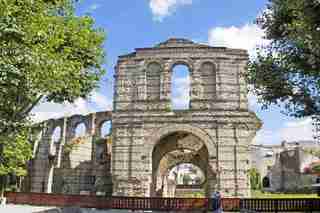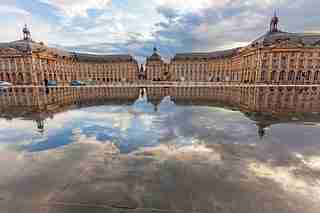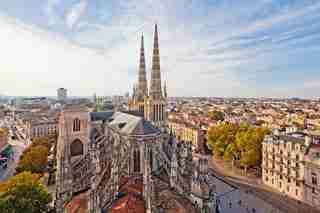Bordeaux’s Architectural Must-Sees

Palais Gallien
The city of Bordeaux dates from the Roman Empire; this ruin of an amphitheater, built in the third century, is all that’s left of that era. Its name comes from the legend, now disproved, that Charlemagne built it as a palace for his wife, Gallienne. rue du Docteur Albert Barraud

Place de la Bourse and Miroir d’Eau
This horseshoe-shaped plaza by the architect Ange-Jacques Gabriel (who also designed Versailles’s Petit Trianon and Paris’s Place de la Concorde) was built in 1755 for Louis XV as a symbol of Bordeaux’s prosperity. On one side is the Bourse (the old stock exchange), and on the other, the Musée National des Douanes (National Customs Museum). Opposite the square is the Miroir d’Eau, designed in 2006 by landscape architect Michel Corajou. The largest reflecting pool in the world, its shallow “mirror”—water about an inch deep—covers 37,100 square feet of granite paving. Place de la Bourse; musee-douaner

Cathédrale Saint-André
This cathedral was consecrated by Pope Urban II in 1096—Eleanor of Aquitaine married Louis VII here in 1137—but much of the building was reconstructed in the 13th through 15th centuries. The cathedral was used during the French Revolution as a place to store animal feed, and was restored in the 19th century. cathedrale-bordeaur
Grand Théâtre
The façade of this neoclassical masterpiece, built in 1780 by architect Victor Louis, is decorated with statues of the goddesses Juno, Minerva, and Venus as well as the nine Muses, all carved by Pierre-François Berruer. The building’s grand staircase inspired Charles Garnier’s design for the one at the Paris Opéra. The theater is now home to the Opéra National de Bordeaux. opera-bordeauom
Grosse Cloche
This medieval bell tower and gate, belonging to the former city hall, was built in the 13th and 15th centuries when Bordeaux was under English rule. With its two towers (it originally had six), unusual solar equation clock, gold-plated leopard weathervane, and 16,500-pound bell, the distinctive structure is an icon of the city, prominently featured on Bordeaux’s coat of arms. rue Saint-James
Tour Pey-Berland
In 1466 this gargoyled Gothic bell tower was built next to Cathédrale Saint-André (although the belfry is not part of the cathedral). Walking up to the top of the tower’s steep, 230-step staircase rewards you with a panoramic view of the city. pey-berlandonuments-nationaur
Porte Cailhau
The only other medieval gate spared, besides Grosse Cloche, when Bordeaux was redesigned by the Marquis de Tourney in the mid-1700s, this 15th-century turreted tower offers terrific views of the Pont de Pierre. Porte Cailhau was originally the arch-gate to the Palais de l’Ombrière—home of the Duke of Aquitaine and later Bordeaux’s parliament—which was demolished in 1800. 23 Place du Palais
Pont de Pierre
In 1819, Napoléon Bonaparte commissioned this stone bridge to connect the left and right banks of the Garonne River. The structure now carries motorists, pedestrians, and—since 2003—Line A of Bordeaux’s 27-mile-long tramway.
Rue Sainte-Catherine
A rue with lots of Gothic and Renaissance character, this is reportedly the longest pedestrian shopping street in Europe. Following the path of an old Roman road, it runs from Place de la Comédie (where the Grand Théâtre is) to Place de la Victoire.
Musée des Arts Décoratifs et du Design
Originally a neoclassical hôtel particulier built by Bordelais architect Étienne Laclotte in 1779, the museum is home to 18th- and 19th-century paintings, furniture, metalwork, ceramics, jewelry, silver, and glass, all displayed in opulent 18th-century townhouse interiors. 39 rue Bouffard
Musée des Beaux-Arts
Around the corner from the Musée des Arts Décoratifs, and housed in two neoclassical wings built by Charles Burguet in 1881, this institution showcases 16th- to 18th-century art in its south wing, and 19th- to 20th-century works in its north. Closed for several years for renovation, the museum reopened in late 2013. musba-bordeaur
Basilique Saint-Seurin
Bordeaux’s oldest church, Saint-Seurin, was founded in the fifth century, but remodeled in later centuries to add Gothic and Romanesque elements. Opposite the church is a crypt dating from the fourth century (discovered during a 1910 excavation) containing Merovingian sarcophagi. Place des Martyrs de la Résistance
Halle des Chartrons
This market hall, constructed of stone, wrought iron, and glass, was built in 1869 by architect Charles Burguet in the quartier des Chartrons, the historic hub of Bordeaux’s wine trade that dates from Roman times. Restored in 1998, the building is now a center for cultural events, concerts, and exhibitions. Nearby are two museums of note, the Musée du Vin et du Négoce, on the history of the wine trade, and the Arc en Rêve Center for Architecture. Place du Marché des Chartrons; museeduvinbordeauom ; arcenreveom